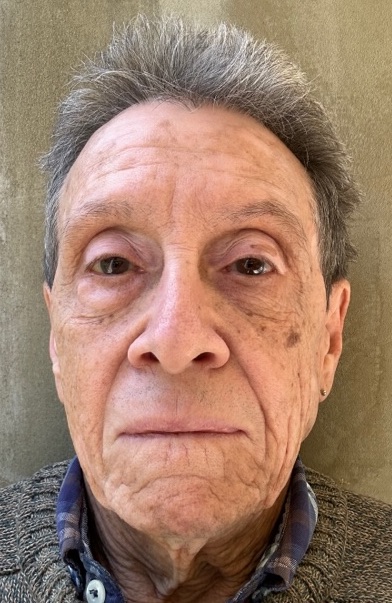
[In spring and summer of 2018 I served as an expert witness in Graham v. Prince et al (15‑cv‑10160) and McNatt v. Prince et al (16‑cv‑08896), providing my services pro bono
At the time I got involved, these cases — filed against wealthy “appropriation art” practitioner and serial hacker Richard Prince by photographers Donald Graham and Eric McNatt for Prince’s unauthorized use of their images — were merged, so my testimony applied to both. Subsequently the cases got separated. Recently, as they headed to trial, they got settled. (See “Richard Prince to Pay Photographers Over $650,000 In Copyright Lawsuits,” by Pesala Bandara, PetaPixel, January 29, 2024.)
I like to think that my rebuttal contributed in some ways to the court’s decision, and also that it makes interesting reading in its own right. (It pleases me to report that Prince and his attorneys repeatedly asked the court to exclude my testimony, which request the court repeatedly denied.) As it’s now on the record as a public document, and the cases have resolved, I’m publishing it here. I’ve stripped out some of the boilerplate — my credentials, etc. — to make it more readable.
Part 4 appears below. Click here for part 1, here for part 2, and here for part 3. If you prefer to read the whole thing, complete with professional boilerplate, you can download a PDF of the brief here.— A.D.C.]
•
U.S. District Court for the Southern District of New York
Case No. 1:16-cv-08896-SHS
Rebuttal Report of Allan Douglass Coleman (d)
… Next, I conclude that the Prince Works are commercial in nature.
For all practical purposes, whatever their respective creative purposes and results may be, Mr. Prince, along with Mr. Graham and Mr. McNatt, make their livings by selling physical versions of their output and licensing derivative uses thereof. Thus they are all entrepreneurs, the sole proprietors of enterprises involving the production of visual images for the marketplace.
I note, in this regard, that Mr. Prince has chosen for his defenders both Allan Schwartzman, currently Chairman and Co-Head of the Fine Art Division of Sotheby’s, one of the world’s foremost auction houses, and Daniel Wolf, owner of an eponymous gallery in New York City from 1977 through 1987, considered by one commentator as “one of the most influential photography dealers in the world.” Both of them, by definition and by proclamation of the defense, are experts in the merchandising of art.
![]() And, having successfully marketed a wide variety of top-dollar “appropriation art,” thereby encouraging its production via the postmodern practice of “appropriation,” both have become complicit in that postmodern practice and have profited handsomely from it. Thus they naturally have a vested interest in defending it.
And, having successfully marketed a wide variety of top-dollar “appropriation art,” thereby encouraging its production via the postmodern practice of “appropriation,” both have become complicit in that postmodern practice and have profited handsomely from it. Thus they naturally have a vested interest in defending it.
The Prince Works at issue here quite clearly were produced by Mr. Prince in his capacity not only as an artist but as an entrepreneur — further evidenced by the fact that the works in question along with the other “New Portraits” works were sold for the profit of Mr. Prince.
•
Next, I conclude that Plaintiffs’ Works are creative and expressive works which qualify as art.
In order to assess the nature of Plaintiffs’ Works, I must begin with a discussion of what it means to be an artist.
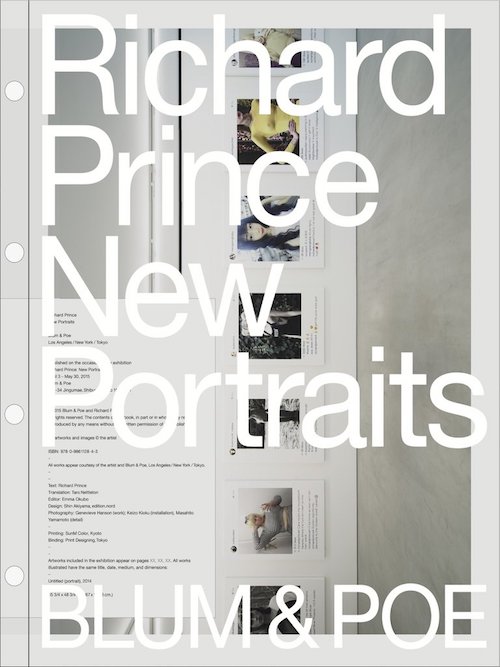
Richard Prince, New Portraits catalog (cover), 2016
While Mr. Prince enjoys the cultural status of artist, I consider it important to note that this title does not qualify as a designation conferred by the legal system. And, given the cultural acceptance of both documentary photography and formal portraiture as modes of creative photography, and thus as art (collected and shown in museums of art, reproduced and discussed in prominent art magazines, etc.), I see no reason not to consider Plaintiffs as artists and their works as art.
I should also point out that it is a given in both modernist and postmodernist discourse that art is whatever an artist says it is — that is, that any object or action, even an idea written down on paper or expressed aloud, can constitute a work of art if someone acting in the role of an artist claims it as such. By that commonly accepted guideline, Plaintiffs’ works are art if they claim them as such.
•
Moving now to the discussion of the nature of the Plaintiffs’ works, the simple fact is this: There are no neutral photographs. As the philosopher of science Thomas Kuhn has pointed out, “any description must be partial.” By its nature, a photograph is a descriptive rather than a transcriptive artifact. As such, it reflects inevitably at least two sets of biases, two viewpoints, on which its existence in the world is predicated:
- Those of the inventors, designers, and manufacturers of the system — camera, lens, film, darkroom equipment and chemistry — employed in the physical production of that particular image.
- Those of the photographer who controls the specific application of that system to the occasion of the image in question.
To assume that these biases merely inflect — or even infect — the photograph is to miss (almost entirely) the point. Which is: This conglomeration of biases, this stew of viewpoints — these are the photograph, these (in combination with its contents, the physical things represented) form its content. Every photograph, therefore, is a manifestation of these biases interacting with whatever was before the lens at the moment of exposure.
This is inescapable. Consequently, any response to a photograph — whether from an actively analytic/critical attitude or a more passively absorptive, spectatorial mode — necessarily involves the viewer with the ostensibly invisible presence of the photographer as well as the more insidiously covert influence of the medium itself.
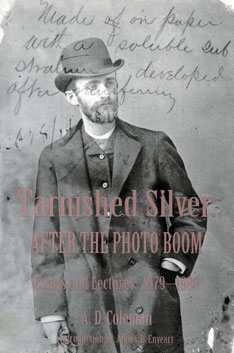
A. D. Coleman, “Tarnished Silver” (1996), cover.
In short, we must think of every photograph as a form of collaboration between subject, photographer, and medium. The last of these operates subcutaneously — beneath the skin of the imagery; most commonly, it calls as little attention to itself as possible, seeking no credit for the final results, even if in fact it dictates them outright. The more immediate, observable transaction is between subject and photographer; it is in this dialogue — sometimes contestual and sometimes cooperative — that control of the final image is negotiated.
In that bargaining the photographer almost always has the upper hand. What I mean by this goes well beyond the fact that some subjects are extremely pliable, perhaps even helpless, insensate, inanimate. Any photographer worth his/her salt — that is, any photographer of professional caliber, in control of the craft, regardless of imagistic bent — can make virtually anything “look good.” Which means, of course, that he or she can make anything look bad — or look just about any way at all. After all, that is the real work of photography: making things look, deciding how a thing is to appear in the image.
For photographs do not “show how things look,” since there is no one way that anything looks. Every thing has an infinitude of potential appearances, a multiplicity of aspects. What a photograph shows us is how a particular thing could be seen, or could be made to look — at a specific moment, in a specific context, by a specific photographer employing specific tools and materials. The photographer, then, is an active partner (most often the dominant one) in the construction of any photographic version of the world.[1]
•
By definition, then, photography as performed by anyone with professional-level skills, such as Mr. Graham and Mr. McNatt, involves a set of both conscious and intuitive decisions that inherently qualify as interpretive, and thus creative. Whether the results qualify as “art” depends on cultural factors that, in my opinion, lie outside the scope of the legal system. As is well-known, the status of photography as an art-making medium was challenged from its very inception, due to the mechanical and scientific component of its tools, materials, and processes.
Responding to that second-class citizenship, such photographers as Alfred Stieglitz, Edward Weston, and Ansel Adams disdained the generic label “artist,” proudly proclaiming themselves photographers. Nonetheless, today their works reside in museums of art around the world, museums that have established departments of photography in recognition of the fact that photography is a medium in which works of art get produced.
Ultimately, in my opinion the Plaintiffs’ Works are creative and expressive in nature and clearly qualify as art.
•
In this section, I analyze the amount and substantiality of Plaintiffs’ Works used in relation to the works as a whole. I conclude that the amount of Plaintiffs’ Works used in relation to the whole of Prince’s Works is substantial.
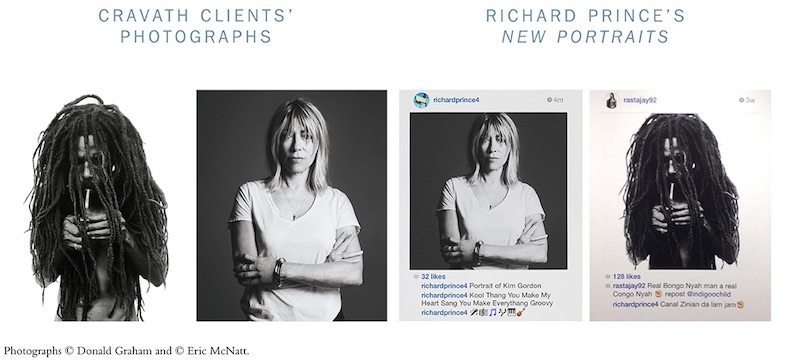
Comparison of Donald Graham and Eric McNatt photos to Richard Prince derivations, Cravath, Swaine & Moore LLP website, screenshot
•
While it is impossible for me to determine the exact extent (if any) to which Plaintiffs’ Works have been cropped around their edges in the process of posting them to Instagram, it is clear to me that this cropping is minimal and does not affect the content of the images as interpretive descriptions of their respective subjects. Further, it is apparent that any such cropping occurred during the original posting of these images by whatever Instagram subscribers put them online, and not during Mr. Prince’s appropriation.
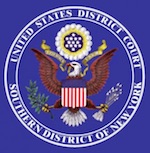 Mr. Prince’s screen grab of these two Instagram posts deliberately captured the entirety of those posts, including the substantial borders that the Instagram posting process automatically places around posted images. If they are indeed cropped, then that alteration was effected by the persons who posted these images to Instagram, not by Mr. Prince in the making of his screen grabs of them.
Mr. Prince’s screen grab of these two Instagram posts deliberately captured the entirety of those posts, including the substantial borders that the Instagram posting process automatically places around posted images. If they are indeed cropped, then that alteration was effected by the persons who posted these images to Instagram, not by Mr. Prince in the making of his screen grabs of them.
I can detect no other alteration of the Plaintiffs’ images themselves as they appeared in those Instagram posts. Given that Mr. Prince discovered a method of “hacking” those posts in order to strip away responses by others and add his own texts, he clearly had the means and opportunity to alter the images themselves, to an extent that might successfully place such alterations within the “fair use” exemption. I see no evidence of any such attempt.
•
Finally, I conclude that the Prince Works, and a ruling in favor of Prince in this case, is likely to have a substantial negative effect upon the potential markets for or value of Plaintiffs’ Works.
Several of Mr. Prince’s defenders propose that the publicity and recognition resulting from Mr. Prince’s unauthorized appropriation of the Plaintiffs’ Works may have a positive effect on their market value in formats authorized by these photographers. I must point out that said hypothetical publicity and recognition would result not from Mr. Prince’s appropriation of these works but rather from their makers’ decision to protect their copyrights via this lawsuit; Mr. Prince thus deserves no credit for that imaginary outcome.
Additionally, I find it hard to imagine that Mr. Prince’s appropriations would lead anyone to their makers, since Mr. Prince deliberately leaves them nameless in his own appropriated works and their accompanying texts.
Furthermore, in response to the fanciful notion that the appropriations have somehow improved the market value of the works in question, it seems no less plausible to me that the precedent set by the court’s approval of Mr. Prince’s usages would encourage others to follow his example by appropriating these and other works by these photographers, thus devaluing not only these two images but putting at risk the entirety of their creative output.
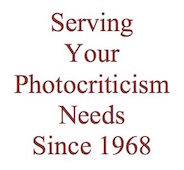 Finally, in this regard, it seems to me that Mr. Prince’s flippant and dismissive relationship to these posts incorporating the Plaintiffs’ images — a trivialization implicit in both his appropriation thereof and his addition of “gobblygook” to them, and explicit in the assertion by Mr. Wolf on his behalf that their works do not qualify as “art” but fall into what he clearly considers the lesser category of “documents” — in fact signifies Mr. Prince’s disrespect for Mr. Graham and Mr. McNatt as fellow artists, which, given Mr. Prince’s prominence as an artist, could certainly have the effect of depressing the market value of these works of theirs in particular and their past, present, and future creative outputs in general.
Finally, in this regard, it seems to me that Mr. Prince’s flippant and dismissive relationship to these posts incorporating the Plaintiffs’ images — a trivialization implicit in both his appropriation thereof and his addition of “gobblygook” to them, and explicit in the assertion by Mr. Wolf on his behalf that their works do not qualify as “art” but fall into what he clearly considers the lesser category of “documents” — in fact signifies Mr. Prince’s disrespect for Mr. Graham and Mr. McNatt as fellow artists, which, given Mr. Prince’s prominence as an artist, could certainly have the effect of depressing the market value of these works of theirs in particular and their past, present, and future creative outputs in general.
In my 50 years in the field I know of no instance in which the market for any visual artist whose work a more famous artist appropriated has increased as a result of said appropriation, nor any instance in which additional recognition, critical attention, or other benefit accrued.
•
In summary, it is my opinion that: (1) the Prince Works are not transformative and are commercial; (2) the nature of Plaintiffs’ Works is creative and expressive; (3) the amount of Plaintiffs’ Works used in relation to the whole is substantial; and (4) the effect of the Prince Works upon the potential market for or value of Plaintiffs’ Works is likely to be substantially negative.
/s/ Allan Douglass Coleman
•
Notes:
[1] Some readers may find the passage above beginning “… the simple fact is this: There are no neutral photographs” oddly familiar. It comes from my essay “The Image in Question: Further Notes on the Directorial Mode,” first published in the Center Quarterly, June 1988, and subsequently republished in my 1996 collection of essays Tarnished Silver: After the Photo Boom. Extracts from my critical writings have appeared in some curious contexts; this numbers among my top ten favorites.
•
This post supported by a donation from Jim Doukas.
•

Special offer: If you want me to either continue pursuing a particular subject or give you a break and (for one post) write on a topic — my choice — other than the current main story, make a donation of $50 via the PayPal widget below, indicating your preference in a note accompanying your donation. I’ll credit you as that new post’s sponsor, and link to a website of your choosing.
And, as a bonus, I’ll send you a signed copy of my new book, poetic license / poetic justice — published under my full name, Allan Douglass Coleman, which I use for my creative writing.






Greetings Thank you for your writing on Artist Richard Prince . Well her we go many moons ago I did a photo series on a abandon basketball courts & hoops I showed them to many galleries thru out N.Y.C and unward no one was interested in them . One day while showing them to a gallery Dir My friend Lance said holy cow it artist Richard Prince he peek at my photos and said tho I rejected once again . Next thing I know Richard Prince did a series base on hoops like mind and they loves OY . As they say What are going to do . Artist Peter Herley Now of Norway Maine .
As a friend of mine used to say, “Plagiarism is the sincerest form of theft.” (He had his work “appropriated” by Wolf Vostell.)
Cool ‘ What are you going to do . Artist Peter Herley .